
Related
Guests
- Jeremy Scahillaward-winning investigative journalist, Democracy Now! correspondent and author of the bestselling book Blackwater: The Rise of the World’s Most Powerful Mercenary Army. His latest piece for The Nation magazine is called “Blowback in Somalia.”
In Somalia, at least 70 people were killed yesterday in the capital of Mogadishu after a large truck bomb exploded near a government compound that housed the Somali cabinet and eight ministries, including the Ministry of Education. The militant group al-Shabab claimed responsibility for the attack, which maintains control of much of southern Somalia. Many in the country blame its refusal to accept Western aid for causing the deadly famine now accompanying a massive drought in the Horn of Africa. We’re joined by award-winning investigative journalist Jeremy Scahill, who was recently in Somalia to report for The Nation magazine. His article “Blowback in Somalia” examines how U.S. policy there has helped create a militant Islamist threat. [includes rush transcript]
Transcript
NERMEEN SHAIKH: In Somalia, at least 70 people were killed yesterday in the capital of Mogadishu after a large truck bomb exploded near a government compound. The attack sent burning bodies across an area several blocks wide in one of the few areas thought to be controlled by the country’s transitional government. The compound housed the Somali cabinet and eight ministries, including the Ministry of Education. Government meetings were underway inside when the blast occurred, but most of those killed or injured were soldiers guarding the compound or students waiting for the results of scholarship exams. The militant group al-Shabab claimed responsibility for the attack.
SHEIKH ALI MOHAMUD RAGE: [translated] Bashir Abdullahi Nur was the martyr today. Al-Shabab is behind the attack. We are still in Mogadishu. How else could we conduct such an attack in the heart of the town? Our intelligence agents who went there before the incident confirmed we have not killed students. We killed over 100 people who were spies, soldiers and security intelligence. The so-called government has started its propaganda. The bomber was a Somali, a resident, and a student who studied at Mogadishu. Somalis, we warn you to keep away from government buildings and military bases, as more serious blasts are coming.
NERMEEN SHAIKH: This was the single most lethal attack by al-Shabab since the group launched an insurgency in 2007. White House spokesman Jay Carney strongly condemned the attack, calling it, quote, “a despicable and cowardly act.” State Department spokesperson Victoria Nuland joined in the condemnation.
VICTORIA NULAND: We obviously condemn, in strongest terms, this terrorist attack against Somali officials. It’s yet another indication, if anyone needed one, of al-Shabab’s complete disregard for human life, and particularly for Somali life.
AMY GOODMAN: Friday’s attack comes as much of southern Somalia remains under the control of al-Shabab. Many in the country blame its refusal to accept Western aid for causing the deadly famine now accompanying a massive drought in the Horn of Africa. The United Nations reports tens of thousands of Somalis have died, and close to a million could soon starve to death.
To talk more about Somalia, we’re joined by award-winning investigative journalist Jeremy Scahill. He was recently in Somalia to report two pieces for The Nation magazine, “The CIA’s Secret Sites in Somalia” and “Blowback in Somalia,” a look at how U.S. policy there has helped create a militant Islamist threat. Jeremy is also the author of the bestselling book Blackwater: The Rise of the World’s Most Powerful Mercenary Army and a Democracy Now! correspondent.
Jeremy, welcome to Democracy Now!
JEREMY SCAHILL: Thank you.
AMY GOODMAN: Lay out what—first, what happened, what we understand to be this latest attack, and how it fits in to blowback.
JEREMY SCAHILL: Well, if you recall, in August of this year, there were all of these reports that al-Shabab was leaving Mogadishu. And al-Shabab, of course, is the militant group that’s pledged its allegiance to al-Qaeda and is the only force in Somalia historically that’s ever included anything resembling foreign fighters. That was, any al-Qaeda presence in Somolia was a force embedded within al-Shabab, although it was a very small foreign presence. But the U.S. has been infatuated with al-Shabab as the sort of premier threat facing East Africa.
So in August, in the midst of the famine, al-Shabab announced a tactical retreat from Mogadishu, the capital of Somalia. The African Union, which is funded and armed and trained by the United States, has about 9,000 troops in Mogadishu. The African Union basically declared victory against al-Shabab. The U.S.-backed Somali government said that, you know, Shabab’s days were over in Mogadishu. And this massive attack not only shows that Shabab is far from gone, but that it has an ability to inflict tremendous damage and to wreak this sort of campaign of terror in Mogadishu that gives lie to the pronouncements of the Somali government and the African Union that they somehow have defeated the insurgency. So, you know, yesterday’s attack was, as you said, the single most lethal attack in Somalia since al-Shabab rose up against the Somali government.
But in a way, this was predictable that this would happen. The United States has been waging an asymmetric warfare campaign throughout the Horn of Africa and extending into Yemen, as we saw by the recent assassination of U.S. citizen Anwar al-Awlaki. The U.S. has begun building new drone facilities in the region. The Obama administration has expanded drone attacks into Somalia. And so, what we’re seeing is U.S. special operations forces and the CIA doing these targeted killings, and then al-Shabab also doing these targeted killings. So this is—this is sort of the new landscape of war. It’s all asymmetric warfare. It’s not military—uniformed militaries fighting one another. It’s these sort of shadow forces from both, you know, what Washington would call a terrorist side of it and then the U.S. military and CIA side of it. They’re both using similar tactics.
AMY GOODMAN: And talk about where blowback fits into this, fits into al-Shabab and the conflict in Somalia now.
JEREMY SCAHILL: Right. I mean, I think before the—before the famine of this year and the drought and grabbing headlines and Angelina Jolie and all these celebrities talking about it, I think for most Americans, Somalia sort of evoked one image, and that was of Black Hawk Down, you know, the infamous shoot-down of a U.S. helicopter in 1993 that ultimately led to the withdrawal of about 20,000 U.S. so-called peacekeepers from Somalia. When 9/11 happened, the Bush administration actually had Somalia on a list of countries that it wanted to intervene in directly. There was a sort of ragtag group of Islamist militants there, and the Bush administration was concerned that they were going to give refuge to al-Qaeda members fleeing Afghanistan when the U.S. went in there. But ultimately, the Bush administration decided not to go into Somalia right away, and instead what it did was to begin waging a proxy war using a network of ruthless warlords. And this network of warlords that were supported by the CIA and U.S. special operations forces after 9/11 had a name that just reeked of CIA involvement. It was called the Alliance for Counter-Terrorism and the Restoration of Peace. And so, these warlords were essentially tasked with hunting down individuals that Washington had determined were al-Qaeda militants or were supporting al-Qaeda.
The end result, though, of this program was that these militia leaders, these warlords backed by the CIA, operated as an effective death squad, believing they had the full support of the CIA. The CIA funded them and gave them lists of people to go after. And so, they started hunting down anyone that they could accuse of being, or did accuse of being, an Islamic radical. But many of the people that were killed by these CIA-funded warlords had nothing to do with al-Qaeda and nothing to do with any form of terrorism. They were prayer leaders. They were principals at madrasahs, religious schools in Somalia, or they were just people that had clan rivalry with the CIA warlords. So, I mean, it’s a classic tale that’s played out through U.S. history. So these warlords were tasked with hunting down what really amounted to about a dozen people, in the—were in the estimation of true Somalia experts, former U.S. diplomats that had worked on the country. And they turned it into these sort of killing fields.
What happened as a result of that is that, regionally throughout Somalia, these Islamic courts started rising up. And they literally were that. They were a Islamic courts. They were a form of justice, because it was lawless in Somalia. The last time there was a stable government there was 1991. And so, these Islamic courts were sort of indigenous movements of religious leaders that were helping to mediate land disputes or implementing some form of a criminal code. And many people, you know, while these courts were very pronounced Sharia court practitioners, brought some semblance of stability to the various regions where they established these courts, while the CIA and the U.S. military began to grow concerned that Somalia was becoming, you know, a pronounced Islamic republic. And so, the warlords, backed by the CIA, intensified their campaign against these Islamic courts. The courts, in turn, got tremendous support from local business people, from clan leaders and others. People were fed up with the warlords, the CIA-backed warlords. So these little autonomous courts formed an Islamic Courts Union and very swiftly, with the support of the vast majority of Somalis across the country, overthrew the CIA warlords and expelled them from Mogadishu and brought stability to Somalia, to the Somali capital, for the first time since the government of Siad Barre fell in 1991. It was a tremendous achievement.
The vast majority of the people involved with these courts were not Islamic radicals, were not supporting al-Qaeda. There were 12 courts. They largely represented Somalia’s clan-based system of governance and decision making. There was a 13th entity within the Islamic Courts Union known as al-Shabab. They were tolerated by people within the courts. They were viewed as sort of radical, outside of the mainstream of Somali society. There’s not an Islamic—a historic Islamic radical tradition in Somalia. And this small group was the group that Osama bin Laden and others exploited, and they started sending in small groups of foreign al-Qaeda operatives to embed within Shabab. But Shabab was kept in check by the other members of these Islamic courts, and they were a ragtag militant group of relative nobodies within Somalia.
In 2006, then, General John Abizaid, the head of U.S. Central Command, gives the green light to the Ethiopian military—Ethiopia and Somalia, sworn enemies, have fought multiple wars—to invade Somalia, 30-40,000 troops, backed by U.S. air power, the CIA and the Joint Special Operations Command. They go in, and they overthrow the Islamic Courts Union—the only government that was able to bring any stability to Mogadishu in a long, long time. And they start killing the leaders and forcing them on the run and rendering them to Djibouti, where the U.S. has a major base. And Somalia then turns into, once again, a state of utter chaos.
Within the context of the U.S. dismantling the ICU, you have al-Shabab, this relatively non-powerful entity, become the vanguard of the fight against the United States and the Ethiopians, who everyone viewed as a proxy for Washington. So they took this group of nobodies, who were the smallest player within this revolution within Somalia, and turned them into the premier vanguard. And al-Shabab, very swiftly, started to capture territory throughout rural Somalia and to wage a very successful, violent insurgency against the U.S.-backed Transitional Federal Government. And that has been the state of affairs since 2007. Shabab control far more territory in Somalia than the U.S.-backed government. And so, you can say that Shabab would not have existed in its current form, had the United States not backed those warlords, had they not overthrown the only real indigenous popular group of people to govern Mogadishu. This would not be happening. The bombings that we’re seeing today would not be happening. Shabab would not be in control of as much territory in the country as they are.
NERMEEN SHAIKH: Can you explain, though, Jeremy—because it seems as though—you mention it in your article, as well, that what the U.S. has done, the counterinsurgency operations in Somalia, are not dissimilar to what the U.S. did both in Iraq and Afghanistan—that is, supporting particular warlords against others. Despite the repeated failure of this strategy, why do they continue to pursue it?
JEREMY SCAHILL: Well, I mean, I think, you know, anyone who pretends to understand why the United States does anything, you know, going back to Central America, the overthrow of various governments, the supporting the Mujahideen, you know, there’s—short-term objectives trump the day. There’s very little long-term strategizing. And so, you know, if you look at the support for the Mujahideen in Afghanistan fighting the Soviet occupation, the U.S. goal was to expell the Soviets. And so, it was—you know, future blowback be damned. And so, you support all these people, and, well, lo and behold, it comes back to haunt us on 9/11 and at other periods. In Iraq, the United States did something very similar. It overthrew the Sunni-dominated government of Saddam Hussein, and then Paul Bremer fires the entire Iraqi military and military leadership, only to then, a couple of years later, have to come back and hire those very Sunnis to fight against what they perceived to be an al-Qaeda campaign inside of Iraq.
So, you know, the bottom line here is that not only did the U.S. support these proxy forces and these CIA warlords and give rise to Shabab, but the people now that Washington is working with are the very people who formed the Islamic Courts Union that the U.S. overthrew. So they’re now backing some of the most notorious warlords that were affiliated with the Islamic Courts Union. In fact, the president of Somalia, Sheikh Sharif Sheikh Ahmed, was the chairman, the head of the Islamic Courts Union overthrown by the U.S. You can go online and see pictures of him shaking hands with Hillary Clinton, Hillary Clinton celebrating him as a partner in the fight against terrorism. I could show you clips of Sheikh Sharif Sheikh Ahmed calling for jihad against the United States. So, you know, what goes around comes around. The United States has a confused policy in Somalia that has primarily benefited the countries of the African Union that have a military campaign going in Somalia and the Islamic radicals from al-Shabab. Those are the beneficiaries of U.S. policy.
AMY GOODMAN: Indha Adde, talk about who he is.
JEREMY SCAHILL: Right. In my piece, “Blowback in Somalia,” I sort of profile four different warlords that have played a major role in both Somali history and in the current situation. Indha Adde was the defense minister of the Islamic Courts Union and, prior to that, was basically just a ruthless, run-of-the-mill, thuggish warlord who controlled a number of territories and a port called the Merca port, and was accused of drug running and weapons trafficking, and then he sort of remade himself as an Islamic sheikh as the Islamic courts started to gain popularity. And he was—you know, he was one of the people that was leading the fight against the U.S.-backed Ethiopian invasion. And he realized, after the Islamic Courts Union had been overthrown, that he either needed to cast his lot with al-Shabab and join the insurgency against the U.S.-backed Ethiopian invasion and the U.S.-backed government, or he needed to flip sides. And so, what he did was he flipped sides, and he is now a three-star general in the Somali military. By some estimates, he’s the highest-ranking military official now in Somalia. And when I met with him in Mogadishu, Indha Adde told me how he proudly harbored Fazul Abdullah Mohammed, the mastermind of the '98 embassy bombings in Kenya and Tanzania. He praised Osama bin Laden as a good religious man. He said that if there was any justice in the world, that George Bush would have been executed like Saddam Hussein. And today he's, you know, basically on the U.S. payroll through its proxies within the African Union.
You know, another warlord that I profiled was a guy named Mohamed Qanyare, who was the main CIA warlord, who—you know, they destroyed Somalia in the early to mid-2000s. And he described to me how the CIA met with him in Nairobi, Kenya, the day after Christmas in 2002, and they created a partnership where the CIA was renting Mohamed Qanyare’s private airstrip—he had his own airport outside of Mogadishu—and that CIA and U.S. special operations agents would fly in once or twice a week to meet with him. They would show him photos of people that they wanted hunted down. And they began grooming this sort of death squad through Mohamed Qanyare. And when I spoke to people within the Islamic Courts Union at that time, but also businessmen and other civilians, they said that Qanyare’s people were literally running around chopping heads off and bringing the heads to the Americans, that they were doing widespread extrajudicial executions, and, you know, that they effectively created the grounds for the Islamic Courts Union to rise up. And Qanyare, who was this longtime CIA warlord, was complaining to me, when I—first of all, he thought I was a CIA agent. He refused to believe that I wasn’t in CIA. I was like, “All you need to do is google Democracy Now! to find us.” But anyway, so I go and I’m meeting with him, and he—so he thinks I’m in the CIA, and he’s complaining that we’ve cut him off — “we” meaning me and the rest of the agency people — that we’ve cut him off, and we’re now working with these Islamic radicals. So, even the old CIA warlords are really upset about what the U.S. is doing. But we’re going to see it, I think—you know, the Shabab is hardly dead. You know, you could say that in some ways it’s stronger than ever.
AMY GOODMAN: Well, I want to thank you very much, Jeremy Scahill, for being with us. Jeremy Schahill, award-winning investigative journalist, writes for The Nation magazine, author of the bestselling book Blackwater: The Rise of the World’s Most Powerful Mercenary Army. His latest piece in The Nation is called “Blowback in Somalia,” and we’ll link to it at democracynow.org.

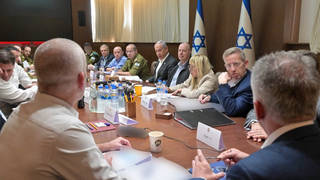

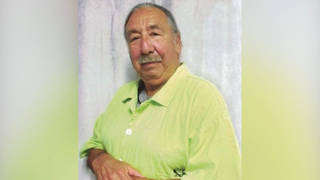
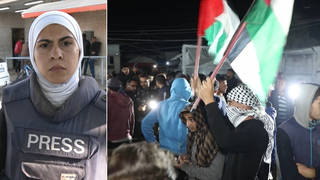
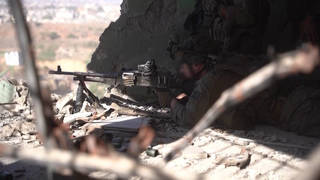




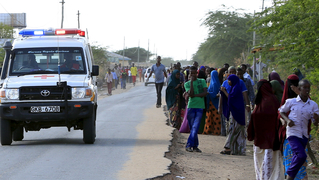
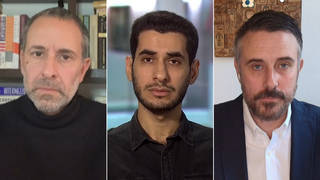
Media Options